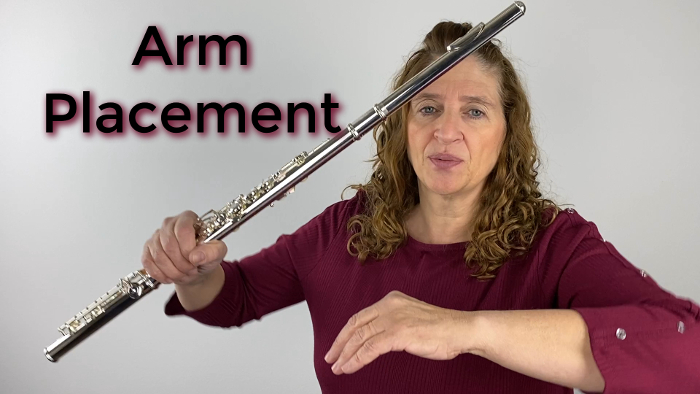Have you ever really thought about your arms when playing flute? What do your arms do? Some people let their arms hang, some bring the left elbow up some look like their arms are barely holding the flute up and some keep them rigidly out marching band style.
Did you know that arm placement can influence your tone? It can also affect the long-term health of your flute playing. There is a lot that can be thought about with the positioning of the arms to help create the most relaxed yet functional flute playing, and the surprising thing is it can affect tone as well.
Let’s get into arm placement and do some experimenting with the position of the arms and the angle of the flute.
I was reading an article by Patricia George who is great teacher and was editor of Flute Talk. She has a series of books with her flute partner Phyllis Avidan Louke. They have many good lesson and exercise books that are really quite valuable. If you haven’t looked at their books, you should. But I was reading what she was suggesting about arm placement and tone, and I thought, you know what, I need to experiment with that.
Prior to this I hadn’t given arm placement a great deal of thought. I certainly had never experimented with changes to see if doing something different would enhance my tone or give more relaxation to the arms and wrists. For this I had to go to the mirror to see what I was doing naturally.
Arm placement
If you ever played in marching band, you know that you are playing with a straight flute and elbows high. It is what is required by band directors. I always know when it’s marching band season because my high schoolers come to with their arms and elbows stiff and straight. And guess what? They are not getting a fantastic tone.
That looks really good in marching band, but it isn’t how you get a great tone and if that posture were to continue you would eventually cause yourself repetitive injury issues. Now, I bet none of you are playing with your arms as straight as that. But look in the mirror and analyze what is happening.
In Patricia George’s post she said (I believe she was quoting one of her teachers) that the only thing that should hang on your flute are your arms and your jaw. I think what is meant by “jaw hanging” is just that you need to have a relaxed embouchure. It should just be loose and relaxed.
What about the arms? If I bring my flute up to my lip, how should my arms be positioned? I’ve had students where they really hang their arms in a not so good way. If they hang too much on the flute, then the fingers are affected and not at their optimal angle. You don’t want anything awkward when you’re talking about your arms. When I put my flute up to my lip, I want a natural angle of flute to arms.
I have often told my students, don’t look like you are hanging on a branch or that you are pulling yourself up and holding so you don’t fall off. There does need to be an angle from fingers through the wrist to your elbow but it’s a relaxed angle in your elbow. I don’t want to do anything forced. When thinking about the right arm and elbow, I generally recommend that you should bisect that angle that would be created from the two extremes. More specifically if you thought about one extreme being your arm is hanging down like you are hanging from a branch and the opposite being that you are marching band straight causing strain on your wrist, that would be a 90-degree angle. Somewhere in between the two is the right place for you. I like to have my students do the marching band position and then lower the elbow until the strain on the wrist goes away. Whatever angle gives you relaxed hands.
Forward Arms
Another point that Patricia George brings up is about how the end of the flute should be past your nose. If you were in marching band that flute is straight from your nose through the shoulders to the end of the flute. This makes the flute line look really good for the judges when they look down the line. What is really suggested here is that the arms should move the flute forward a bit so that there if someone were to look sideways at you with your flute up, they would see the flute create a bit of an angle between your embouchure and the end of the flute.
The idea is that this position gives you more projection, a bigger sound and better intonation.
Stand in front of a mirror and experiment with pushing the flute a bit forward. Do your usual way and then move the end of the flute forward and see what this does for your playing. Use a tuner and see what difference that can make.
Always remember that experimenting for what works best for you is the goal. The goal is not to do everything exactly as everyone else says to do it. By experimenting with these ideas, you can find what works best for you.
So, perhaps you need to change your angle. I’m here to give you the freedom to just try it. Sometimes, we get stuck and don’t think we can change but we can!
Experiment with the position of your arms and their angle and see what gives you the most relaxed arms and the best sound!
Have fun!
DoctorFlute
Watch me demonstrate this:
Arm Placement for Better Tone – FluteTips 180


10 Commonly Asked Questions About the Flute – FluteTips 143

